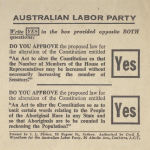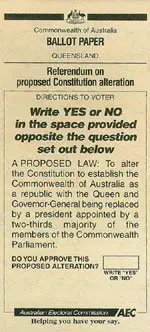 One obvious method of altering law-making power in Australia is to change the Commonwealth Constitution. The ‘Founding Fathers’ who drafted the Constitution included a process by which it could be amended. Constitutional reform is addressed in Section 128, which outlines a two-step process involving both the Federal Parliament and the voters of Australia. It is a more complex, expensive and democratic process than normal legislation because it requires the approval of the Australian people, not just the parliament. Changing the Commonwealth Constitution is very difficult to achieve. Since Federation in 1901, the Australian people have voted on 44 proposed changes to the Constitution; only eight of these have been accepted. The last Commonwealth referendum was in 1999 when the Australian public voted on two issues: whether to replace the constitutional monarchy and governor-general with a republic and a president; and whether to add a new preamble to the Constitution. Both proposals were rejected by the Australian people.
One obvious method of altering law-making power in Australia is to change the Commonwealth Constitution. The ‘Founding Fathers’ who drafted the Constitution included a process by which it could be amended. Constitutional reform is addressed in Section 128, which outlines a two-step process involving both the Federal Parliament and the voters of Australia. It is a more complex, expensive and democratic process than normal legislation because it requires the approval of the Australian people, not just the parliament. Changing the Commonwealth Constitution is very difficult to achieve. Since Federation in 1901, the Australian people have voted on 44 proposed changes to the Constitution; only eight of these have been accepted. The last Commonwealth referendum was in 1999 when the Australian public voted on two issues: whether to replace the constitutional monarchy and governor-general with a republic and a president; and whether to add a new preamble to the Constitution. Both proposals were rejected by the Australian people.
A proposed constitutional amendment begins its life as a bill, like any item of ordinary legislation. The bill containing the proposed amendment is submitted to either house of parliament, where it undergoes a first and second reading, debate and motion. If it passes the initial House then it moves to the other House, where the process is repeated. If it passes both Houses then the proposal proceeds to a referendum. If one House rejects the proposal then it can still proceed to referendum; this is determined by the Governor-General, on the advice of the Prime Minister. An example of this occurred in 1974 when the Whitlam government moved four proposed amendments to referendum after they had been rejected by the Senate.

Constitutional referendums are organised, conducted and overseen by the Australian Electoral Commission, a statutory authority that works independently of the government. Referendums are conducted under similar conditions to Federal and State elections. Attendance is compulsory for all registered voters. Registered voters receive a ballot paper (see the example, right) that states the proposed change to the Constitution and asks them to vote ‘yes’ or ‘no’. They complete and lodge this as a secret ballot. Papers are opened, sorted and tallied under scrutiny.
Section 128 sets criteria that must be met for a referendum proposal to succeed and be adopted in the Constitution. The most significant requirement is the need for proposals to obtain a double majority: an absolute majority of all Australian voters and an absolute majority of the States (at least four of the six States). The double majority serves to protect the smaller States, whose interests might be ‘swamped’ by the voting power of heavily populated states like New South Wales and Victoria. There is also an additional provision, sometimes referred to as the triple majority, which requires States to support proposed amendments that specifically affect them. For example, a constitutional amendment to alter a State boundary or reduce its representation in parliament could only pass if the State in question voted to support it.
© lawgovpol.com 2014. Content on this page may not be republished or distributed without permission. For more information please refer to our Terms of Use.
